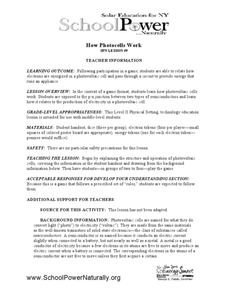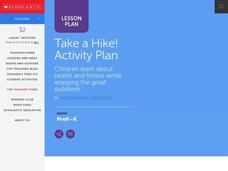Curated OER
Creating Energy From Water
Students study water and its energy. In this water energy lesson, students discuss hydroelectricity and make models of water turbines.
Curated OER
Simplified Vertical Rebound Testing
Learners participate in a lab activity in which they examine a simple energy transformation system. Students test the rebound of elastomers, produce rebound data, and determine the kinetic energy transformed by the impact of a free...
Curated OER
Mice Rule!
Pupils explain what biodiversity is and how adaptive features are maintained in a population. In this biodiversity instructional activity students complete a simple activity involving mouse populations.
Curated OER
Got Gas? How Much?
Students perform an experiment that measures respiration. In this performing an experiment that measures respiration lesson, students discuss aerobic and anaerobic respiration. Students measure the gas produced by putting yeast in...
Curated OER
Protecting the Mummified Troll
Pupils develop an invisible security system to protect a mummified troll. In this security system lesson plan students view a portion of Mythbusters and begin their challenge.
Curated OER
HABITAT for the other 90%
Learners examine the connection between the habitat needs of endemic species to the habitat needs of humans. In this habitat lesson learners research the habitat requirements of a given family then develop an idea to improve the habitat...
BioEd Online
Gravity and Buoyancy
Would a baggie filled with water have the same shape sitting on a table as it would in a bucket of water? Why not? Allow learners to find out first-hand the effects of gravity acting alone on the baggie, as well as when gravity is...
Curated OER
How Photocells Work
Give small groups of physical scientists tokens that represent electrons in a photovoltaic cell. They play a dice game in which they move the tokens around, representing the flow of electrons through the p-n junction of a semiconductor...
Curated OER
Pyramid Building: How to Use a Wedge
Students explore the simple machine of a wedge. In this wedge lesson, students test wedges on different materials including wax, soap, clay and foam. They learn how a wedge was used to build the ancient pyramid and modern day skyscrapers.
Curated OER
Interplanetary Travel Guide
In groups of six, middle school space scientists create an imaginative travel brochure for attracting visitors to the planet Mars. Information must include surface features and atmospheric conditions. Although time-consuming, this is a...
Curated OER
Keys and Webs
Students explore and classify organisms found in a Rocky Mountain Ecosystem. Through discussions, students examine the effects upon an ecosystem if a component was removed or a new component was added. As a class, they survey reasons...
Curated OER
Creating New Forms of Life
Although not particularly educational, here is a creative group activity in which high school biologists will use their imaginations to create a new life form combining characteristics from existing life forms. Each group must come up...
Curated OER
All Ears for Adaptation
Young scholars discuss different characteristics that enable animals to adapt to their environments. They work in pairs with one partner standing about one foot behind the other partner and cup their hands around their ears with palms...
Curated OER
Flip Books!
These aren't exactly worksheets, but rather a selection of pdf files of different atmospheric or solar events. Print your chosen pdf file for each aspiring astronomer in your class, have them cut out the individual mini pages, arrange...
Curated OER
Bye-Bye Bison
Fourth graders investigate the bison's struggle for survival. They discuss the importance of bison while participating in an role playing activity showing how important the food supply and surroundings are to their survival.
Curated OER
Marshland Ecosystem
Students classify animals based on their physical characteristics and eating habits. In this animal identification lesson plan, students investigate the life forms shown on a Parisian ceramic basin, and discover ecosystem the artist was...
Curated OER
Properties of Matter
Third graders explore forms of matter through reading, hands-on science activities, and research using the Internet. Students create a booklet, directions given, that they title and decorate, to later serve as a review visualization...
Curated OER
Activity #9 Tye Green Blob
Students comprehend that a chemcial change produce substances with a different composition and physical and chemcial properties. They state the differences between physical and chemical changes. Pupils observe changes that occur during...
Curated OER
Activity #18 Decompostion of Baking Soda
Pupils observe what occurs as baking soda is heated. They explain why a chemical rather than a physical change occurred during the procedure. Pupils identify the tpe of reaction (decomposition). Students conduct a glowing splint test...
Curated OER
Activity #15 The Snowy Christmas Tree
Middle schoolers weigh out the proper amount of silver nitrate and prepare the silver nitrate solution. They observe what occurs when pure copper is added to silver nitrate solution. Pupils determine whether the change in the appearance...
Curated OER
Putting the 'pi' in Pumpkin Pie
Students use geometric formulas to divide a pumpkin pie. In this geometric formulas lesson plan, students review equations for area and circumference of a circle and divide a pumpkin pie to practice the formulas. Students use the...
Curated OER
Take a Hike!
Students explore the benefits of staying active by going on a hike. In this physical education lesson, students discuss the concept of a hike, where a good place to hike is and what types of foods are necessary to stay nourished....
Curated OER
Weather
Students participate in a variety of mini-lessons including experiments, literature readings, physical education components, music, data gathering and recording and more to expose them to several themes of weather; i.e. water cycle,...
Curated OER
Tin Can Stilt Walkers
Students make tin can stilt walkers. In this stilt walkers lesson, students use 48 ounce size cans to make stilt walkers. They practice walking on them to improve their balance in this environmentally friendly art and physical education...

























